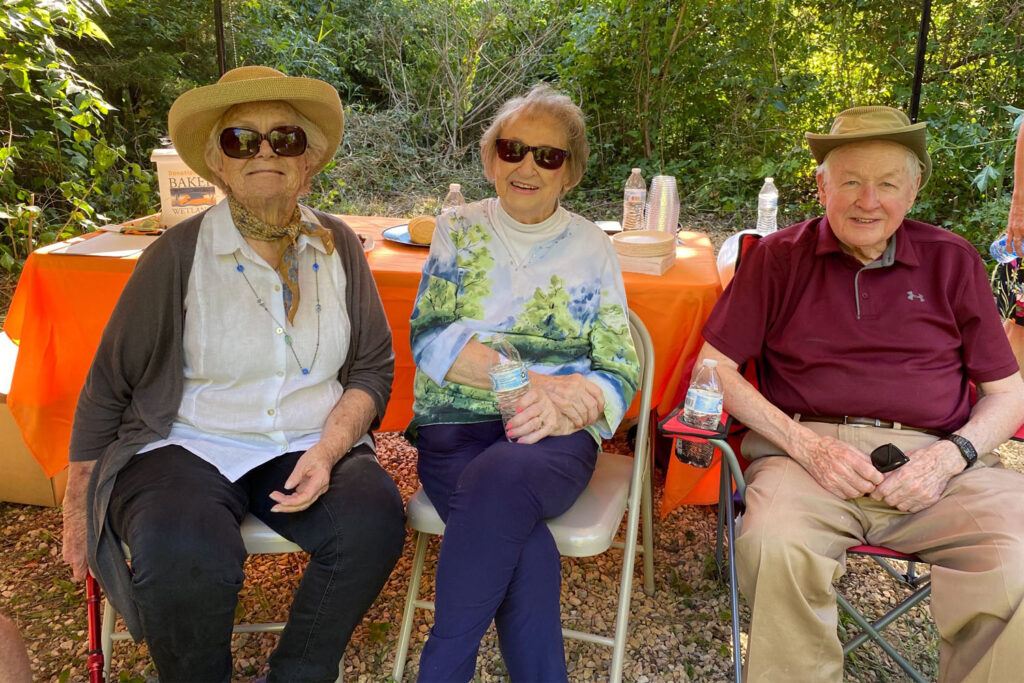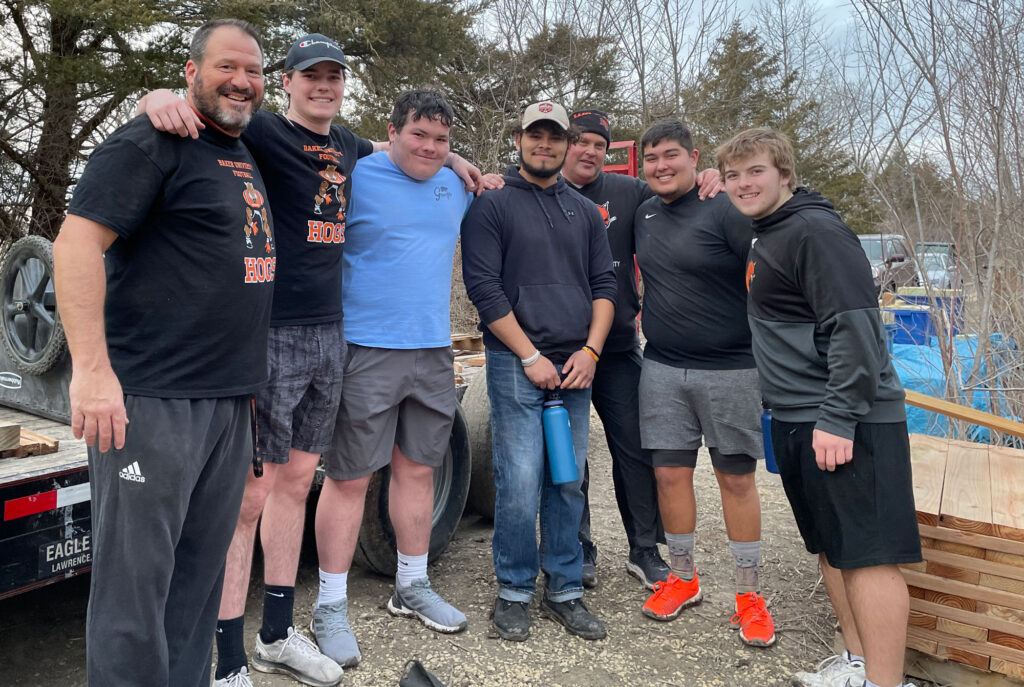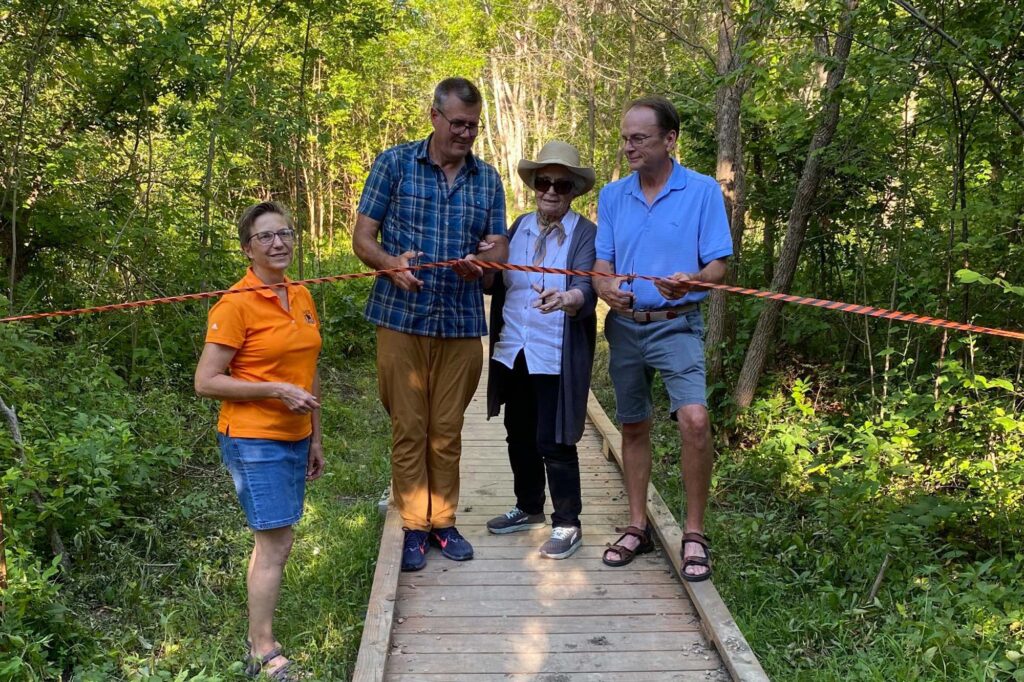The opening of a new boardwalk at the Baker University Wetlands will allow students, faculty, and the public to study and enjoy a unique habitat. The boardwalk was officially opened with a ribbon-cutting ceremony on July 12. Cutting the ribbon were Dr. Irene Unger, director of the Wetlands and professor of biology; Stan Rasmussen, past president of the Jayhawk Breakfast Rotary Club; Eleanor (Mize) Head, ’53; and Doug Paul, Rotary Club member.
The new boardwalk is in an area and habitat that was not previously accessible to visitors. Because the area is a seasonally wet swamp, Associate Professor of Biology Dr. Scott Kimball, ’99, said it could not be accessed without a boardwalk.
“Over the years, the area where we built the boardwalk has slowly been going through a process called succession, wherein the plant community changes from an early stage to a more mature stage,” he said. “This area is becoming a seasonally flooded forest as the cottonwoods, silver maples, and green ash trees mature.”
Wildlife Watching
Kimball helped determine the path of the new boardwalk.
“Having conducted several bird surveys through the years in this area, I knew the basic layout of this area and had seen it as it changed through the seasons,” he said. “I basically thought of a path through the site that would afford some nice views of the various habitats and good opportunities for wildlife watching, too.”

Unger said the new boardwalk creates new opportunities.
“Birders will find species along this boardwalk that won’t be found in other places at the Wetlands,” she said. “The boardwalk will open this habitat up for field trips by Baker students as well as for new outreach and education activities by the Wetlands’ staff. Baker students may use the site for research in addition to class activities.”
This area is the largest tract of swamp and the most accessible of this habitat type, Kimball said.
“There are many species of birds that might prefer this habitat, and as it continues to mature, we should expect to see changes in the community of organisms that call this area home,” he said. “Our students and the general public will now be able to witness these changes. We will be able to take advantage of access to a unique habitat type, presenting opportunities for Irene [Unger] and I to teach and for our students to learn about these areas.”
A Lasting Gift
Contributions from friends and family of the late Kenneth Head, ’53, combined with a gift from the Jayhawk Breakfast Rotary Club and an anonymous donor, funded $22,000 of the $34,000 project, Unger said. Work began in October 2021 and wrapped in April. (Read more about the donations for this project.)

Stan Rasmussen was serving as the new president of the Jayhawk Breakfast Rotary Club in July of 2020 when discussions about the boardwalk began.
“It was still early in the pandemic, and Covid was disrupting meetings and life in general,” he said. “I was trying to identify a community service project that would not be significantly impacted by Covid and thought that an outdoor project might work. I also knew our club could apply for Rotary grant funds and was confident that between our club’s matching contribution and the grant funds, we could get $5,000 to put toward a project.”
Rasmussen contacted Unger and asked if she had projects at the Wetlands where Rotarians could be involved. “Dr. Unger told me on the phone that she couldn’t believe the timing of my call. She told me that she had been contacted by a couple who wanted to remain anonymous who were offering to make a $5,000 donation if she could get matching funds. It seemed like it was meant to be.”
Ultimately, the Jayhawk Breakfast Rotary Club donated more than $8,000, and 16 Rotarians provided more than 500 hours of labor during 28 work days, Rasmussen said.
“We are proud of this project,” he said. “There was a lot of great teamwork, and this is a lasting gift to the Lawrence and Douglas County community.”
Help from the Rotary club was invaluable, Unger said. “We could not have done this project without their expertise, their hard work, and their dedication to working in sometimes difficult conditions.”
A Very Pretty Place
The Rotary club members weren’t the only ones lending a hand. The boardwalk project also involved some of Baker’s football team.
“We only cleared as much vegetation as needed to be able to work the site,” Unger said. “Therefore, once the pilings were in place, we could no longer take machinery into the site. This meant that all the lumber had to be moved in by hand.”
She said the lumber for the stringers was awkward and heavy, and moving it was proving to be difficult for the Rotarians, most of whom are retired.
“I happened to run into Assistant Coach [Brian] Boyle, ’97, at the right time,” Unger said. “I asked if he had some team members who could help, and he managed to get five or six guys—mostly members of the offensive line—out on two different occasions. Each time, the team members spent two to three hours at the site.”

The new boardwalk is most easily accessed via the parking lot off Haskell Avenue. It is a short walk—one-half to two-thirds of a mile—to reach the boardwalk along a pre-existing trail. Unger said visitors can create a loop, as both ends of the boardwalk connect to other trails. The boardwalk itself is a wooden path, about 40 inches wide that is 1 to 3 feet off the ground. There are “turnouts” every 200 to 250 feet along the trail for benches or to allow wheelchairs to pass each other. The Rotarians as well as the Head family have donated benches for the boardwalk.
“The walkway is over water, and thus it is possible to see frogs, turtles, and snakes in addition to a number of birds along the trail,” Unger said. “A good portion of the trail is shaded by cottonwoods. Other stretches are more open with cattails and other emergent vegetation flanking the boardwalk. It is a very pretty place—peaceful.”
Written by Jenalea Myers, ’08





